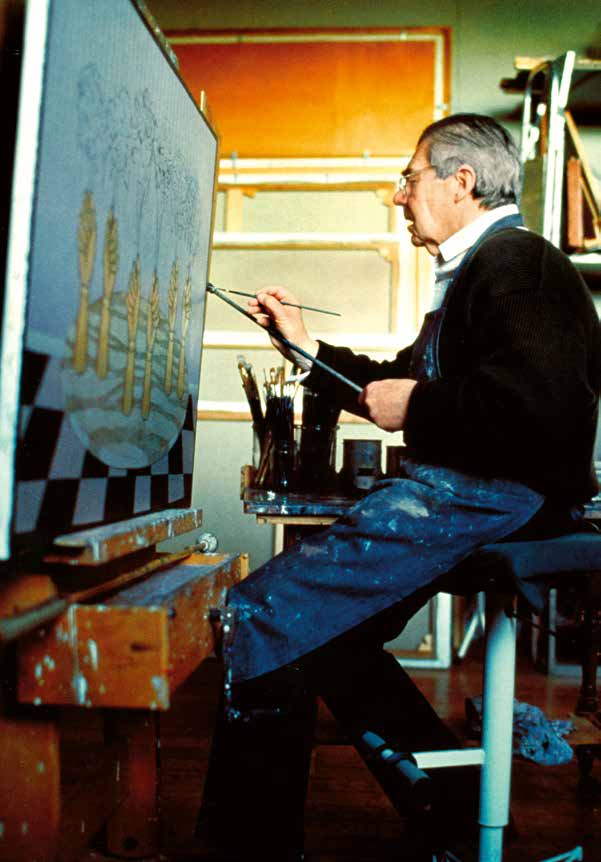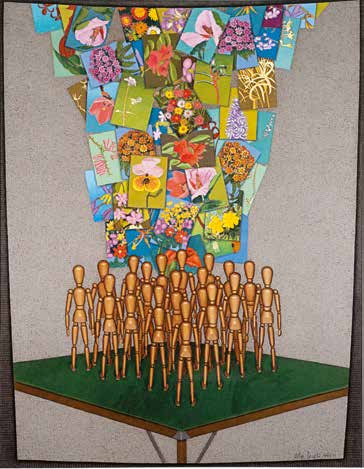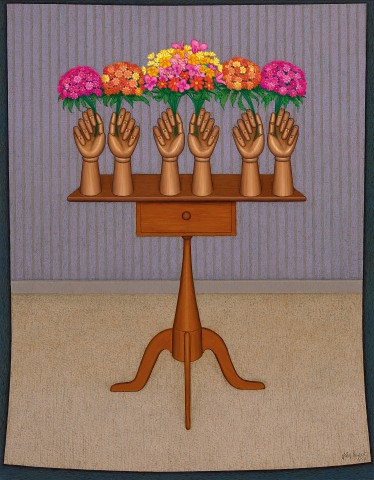POSIES, 1990
JOHN BRACK
oil on canvas
137.0 x 106.5 cm
signed and dated lower right: John Brack / 1990
inscribed with title on artist's label verso: POSIES
Tolarno Galleries, Melbourne (label attached verso)
Joan Clemenger AO and Peter Clemenger AO, Melbourne, acquired from the above in September 1991
1 brack 2.jpg

John Brack’s motivation for painting remained consistent throughout his career. In 1956, following the National Gallery of Victoria’s purchase of Collins St, 5p.m., 1955, he wrote to Eric Westbrook, the gallery’s director, explaining, ‘One either has a subject, or one has not… If I choose to paint the life I see around me, it is because I find people more interesting than things.’1 Finding subject matter in his immediate surroundings, Brack satisfied this intense interest in people, and paintings such as The New House, 1953 (Art Gallery of New South Wales) and The Bar, 1954 (National Gallery of Victoria) still stand as acute observations of modern Australian life. While the clothing, hairstyles, interiors and other accoutrements of mid-century suburban life imbue these paintings with a strong sense of nostalgia, it is what they reveal about human behaviour and its inevitability, irrespective of the era, that is most compelling. It is this element which also provides the thematic link between Brack’s figurative paintings of the 1950s and 60s and his later works. From the early 1970s on, the human figure disappeared from his paintings almost entirely, replaced by inanimate objects – museum postcards, umbrellas, pencils, playing cards and wooden artists’ manikins, among others – which were combined with various domestic props to construct subtle visual metaphors. As Sasha Grishin wrote, ‘Brack’s new approach [permitted] him to express the whole complexity of social interconnections’2 and his perspective on the perennial forces of human nature was transformed from one that was local to a broader more universal view.
Produced in Brack’s studio, the late paintings were the result of intense preparation and a meticulous technique. He would set up elaborate tableaux, using fishing line and tape to suspend props when necessary, and create a model from which a detailed preparatory drawing was then made. He also used fine brushes and glazes to minimise the appearance of brushstrokes and heighten the sense of pictorial realism in these works, the aim being to engage viewers so that they could focus on the meaning of his imagery rather than being distracted by expressive painterly bravura.3 A dark, irregular border surrounding these scenes also became a familiar element of the late works. Highlighting the illusionistic nature of painting, as well as Brack’s remarkable skill, it also points to the possibility of other realities. As Helen Brack observed, ‘The margins here are very important, because they are about the dark past, other ages. He was extremely interested in how you can use structure to say what you want to say.’4
1 brack.jpg

Painted in 1990, Posies came towards the end of Brack’s career. He turned seventy that year and would stop painting altogether four years later. Many of the works made at this time show the artist reflecting on his life as well as looking forward. ‘John was getting older, and so he was starting to think of the future – not his future but the future. And when the 1980s came (and it did synchronise with grandchildren coming) there was a realising that it was the same again – we’d very much seen this, been there. That was the beginning of his making an image for perpetuation … There is an optimism at the end of John’s life that wasn’t there earlier.’5 The floral subject and joyous colours of this picture create an air of celebration which is also present in related contemporary paintings such as Watching the Flowers, 1991 and Six Bouquets, 1991 (both private collection). Unlike the floral still-lives Brack had painted during the late 1950s, which depicted cut flowers in vases – carnations, gerberas and solandra – just as you might find them in a mid-century suburban home, the domestic setting here is artificial, carefully constructed like a stage set which deliberately emphasises some details and omits others. Although cool and restrained, the flecked carpet and subdued striped wallpaper of this environment clearly connects to notions of home. More importantly, it also connects to family, a theme which was particularly prominent in Brack’s work during these years. The articulated wooden hands often stand in for people in these late paintings and in this image, it is possible to see them as representing Brack and his wife, Helen – the central pair holding the larger posies – surrounded by their four daughters. The variations between the posies subtly distinguish between the generations – larger bouquets and more varied flowers symbolising the age and experience of the parents, for example – as well as between each individual. In the same way, the similarities between each posy simultaneously reflect the immutable biological connection that unites them. A still life. A family portrait. A floral tribute.
John Brack has long been recognised as a towering figure within twentieth century Australian art, one of the few artists of his generation who addressed the reality of life as it was lived in the cities and the suburbs. As Patrick McCaughey observed however, ‘even if he may look direct, accessible and easy to read… the imagery retains an ambiguous and enigmatic quality. Paintings infer hidden meanings; references just beyond the grasp or consciousness of the viewer.’6 A still life then, is more than just a still life. In Brack’s hands, they ‘offer an alternative route. They give back to painting the richness and ambiguity of metaphor. The paintings and their images stand for more than their literal presence.’7
1. Brack to Eric Westbrook, 15 April 1956, National Gallery of Victoria Artist File
2. Grishin, S., The Art of John Brack, Oxford University Press, Melbourne, 1990, p. 140
3. Ibid., p. 132
4. Brack, H., quoted in Gott, T., A Question of Balance: John Brack 1974 – 1994, Heide Museum of Modern Art, Bulleen, 2000, p. 11
5. Ibid., p. 34
6. McCaughey, P., ‘The Complexity of John Brack’ in Lindsay, R., John Brack, National Gallery of Victoria, Melbourne, 1987, p. 7
7. Ibid., p. 9
KIRSTY GRANT
